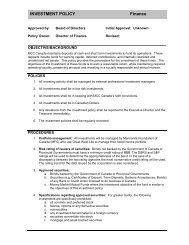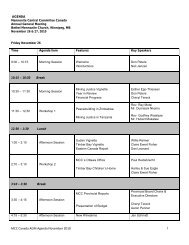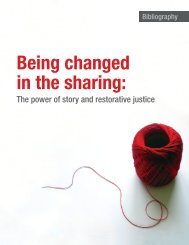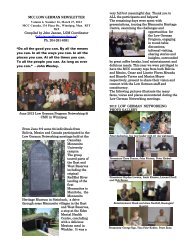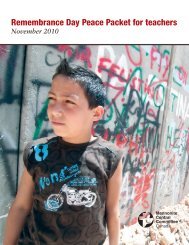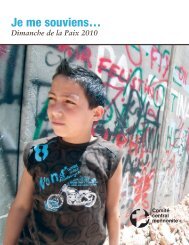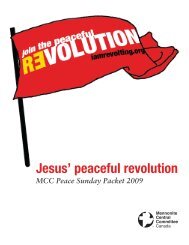Walking together: Healing and hope for Colombian refugees
Walking together: Healing and hope for Colombian refugees
Walking together: Healing and hope for Colombian refugees
You also want an ePaper? Increase the reach of your titles
YUMPU automatically turns print PDFs into web optimized ePapers that Google loves.
w a l k i n g<br />
t o g e t h e r<br />
31<br />
PHASES OF REFUGEE ADJUSTMENT<br />
Phase 1 (Arrival)<br />
SATISFACTION<br />
Phase 2 (Reality)<br />
Phase 3A (Negotiation)<br />
Phase 3B (Alienation)<br />
Phase 4A<br />
(Integration)<br />
Phase 4B<br />
(Marginalization)<br />
TIME IN COUNTRY<br />
Phases of Refugee Adjustment chart courtesy of the Center <strong>for</strong> Victims of Torture, 649 Dayton Ave., St. Paul,<br />
MN 55104, www.cvt.org © Center <strong>for</strong> Victims of Torture<br />
lead to feelings of confusion <strong>and</strong> disorientation. Feelings of numbness, anger, or even resentment can<br />
also be present in this stage.<br />
Phase Two generally occurs after three to six months <strong>and</strong> is called the Reality Phase. In this phase the<br />
refugee comes down from the “high” of the honeymoon as they realize that their desire <strong>for</strong> a quick<br />
adjustment has not been met. They become increasingly aware of the challenges that lie ahead <strong>and</strong> may<br />
begin to feel overwhelmed. Culture shock begins to set in <strong>and</strong> the reality of their losses is recognized.<br />
Conflicts may arise between generations in the family, with other refugee communities or between the<br />
family <strong>and</strong> the host community. Memories of traumatic events may occur (see Flashbacks, p 63), <strong>and</strong><br />
with them a sense of fear may return. In this stage<br />
<strong>refugees</strong> may experience difficulty concentrating<br />
in English class, detachment, short-term memory<br />
loss, fatigue or other physical symptoms such<br />
as headaches or stomachaches. The supportive,<br />
encouraging presence of the church in the lives of<br />
the <strong>refugees</strong> is crucial at this point; it can make all<br />
the difference in the path that the refugee family will<br />
take in the next stages.<br />
Phases Three <strong>and</strong> Four each have two optional<br />
paths: one gradually leading to Integration <strong>and</strong> the<br />
other leading toward Marginalization. Most <strong>refugees</strong><br />
that are sponsored by church communities are able<br />
to follow the path to integration, over time navigating<br />
their way to belonging in their new community.<br />
“I want to emphasize the importance of the role of<br />
churches in Canada. I remember one day I read<br />
on a Canadian five dollar bill ‘The winters of my<br />
childhood were long, long seasons. We lived in three<br />
places - the school, the church <strong>and</strong> the skating rink<br />
- but our real life was on the skating rink.’ It seems<br />
to me that this is a peaceful <strong>and</strong> humane country<br />
because of the presence of the church in families.<br />
Meeting with so many people at church, sharing<br />
<strong>together</strong> in different ways <strong>and</strong> singing beautifully -<br />
this brings us much life.”<br />
- Jose



